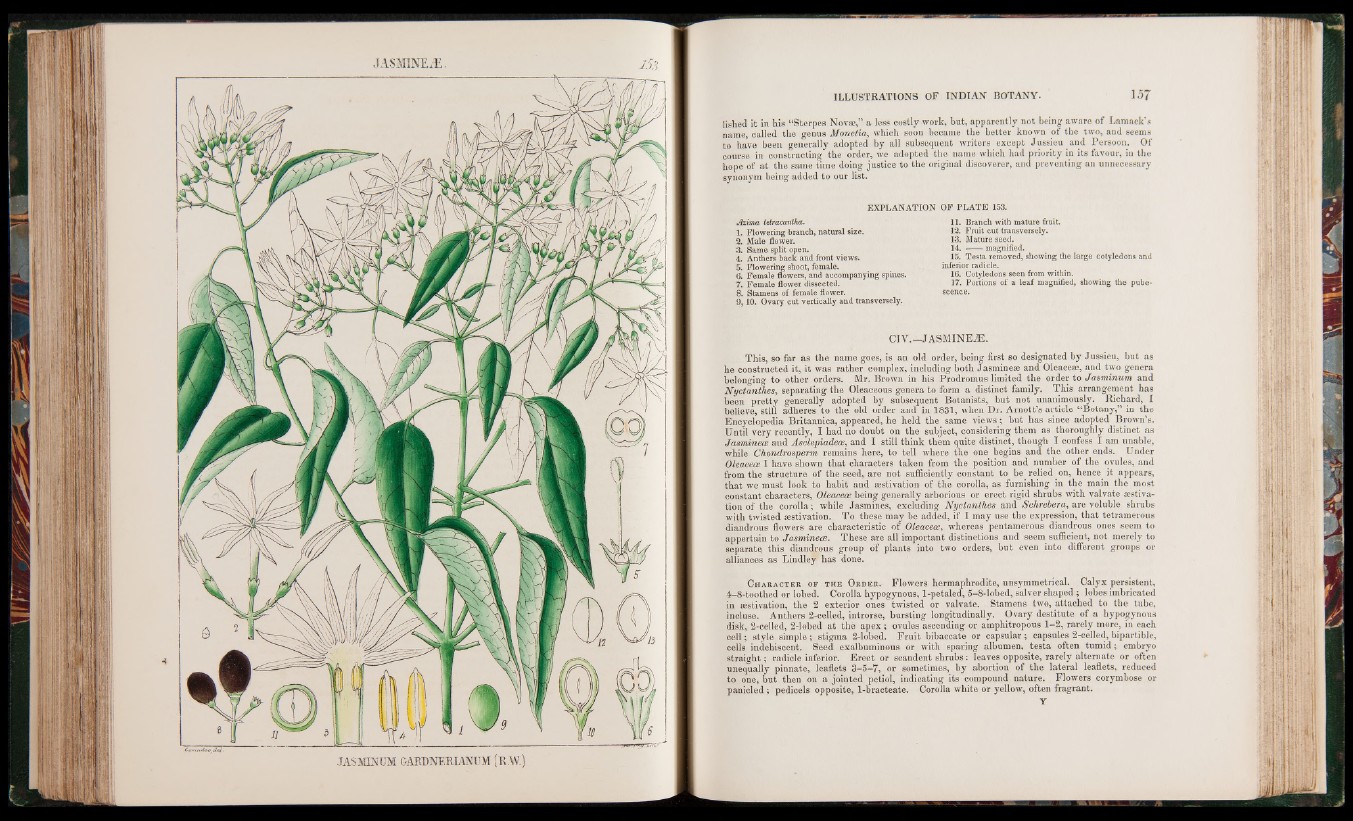
JAS.MINEÆ. j.
JASMIN CM &ARD3VERIANUM (R.W.)
lished it in his “Sterpes Novoe,” a less costly work, but, apparently not being aware of Lamack’s
name, called the genus Monetia, which soon became the better known of the two, and seems
to have been generally adopted by all subsequent writers except Jussieu and Persoon. Of
course in constructing the order, we adopted the name which had priority in its favour, in the
hope of at the same time doing justice to the original discoverer, and preventing an unnecessary
synonym being added to our list.
EXPLANATION OP PLATE 153.
»9zima tetracantka.
1. Flowering branch, natural size.
2. Male flower.
3. Same split open.
4. Anthers back and front views.
5. Flowering shoot, female.
6. Female flowers, and accompanying spines.
7. Female flower dissected.
8. Stamens of female flower.
9 ,1 0 . Ovary cut vertically and transversely.
11. Branch with mature fruit.
12. Fruit cut transversely.
13. Mature seed.
14. f e ^ magnified.
15. Testa removed, showing the large cotyledons and
inferior radicle.
16. Cotyledons seen from within.
17. Portions of a leaf magnified, showing the pubescence.
CIV.—JASMINE JE.
This, so far as the name goes, is an old order, being first so designated by Jussieu, but as
he constructed it, it was rather complex, including both Jasmineae and Oleaceae, and two genera
belonging to other orders. Mr. Brown in his Prodromus limited the order to Jasminum and
Nyctanthes, separating the Oleaceous genera to form a distinct family. This arrangement has
been pretty generally adopted by subsequent Botanists, but not unanimously. Richard, I
believe, still adheres to the old order and in 1831, when Dr. Arnott’s article “Botany,” in the
Encyclopedia Britannica, appeared, he held the same views; but has since adopted Brown’s.
Until very recently, I had no doubt on the subject, considering them as thoroughly distinct as
Jasminece and Asclepiadece, and I still think them quite distinct, though I confess I am unable,
while Chondrosperm remains here, to tell where the one begins and the other ends. Under
Oleacece I have shown that characters taken from the position and number of the ovules, and
from the structure of the seed, are not sufficiently constant to be relied on, hence it appears,
that we must look to habit and aestivation of the corolla, as furnishing in the main the most
constant characters, Oleacece being generally arborious or erect rigid shrubs with valvate aestivation
of the corolla; while Jasmines, excluding Nyctanthes and Schrebera, are voluble shrubs
with twisted aestivation. To these may be added, if I may use the expression, that tetramerous
diandrous flowers are characteristic of Oleacece, whereas pentamerous diandrous ones seem to
appertain to Jasminece. These are all important distinctions and seem sufficient, not merely to
separate this diandrous group of plants into two orders, but even into different groups or
alliances as Bindley has done.
Character of the Order. Flowers hermaphrodite, unsymmetrical. Calyx persistent,
4-8-toothed or lobed. Corolla hypogynous, 1-petaled, 5-8-lobed, salver shaped ; lobes imbricated
in aestivation, the 2 exterior ones twisted or valvate. Stamens two, attached to the tube,
incluse. Anthers 2-celled, introrse, bursting longitudinally. Ovary destitute of a hypogynous
disk, 2-celled, 2-lobed at the apex; ovules ascending or amphitropous 1-2, rarely more, in each
cell; style simple ; stigma 2-lobed. Fruit bibaccate or capsular; capsules 2-celled, bipartible,
cells indehiscent. Seed exalbuminous or with sparing albumen, testa often tumid; embryo
straight; radicle inferior. Erect or scandent shrubs: leaves opposite, rarely alternate or often
unequally pinnate, leaflets 3-5-7, or sometimes, by abortion of the lateral leaflets, reduced
to one, but then on a jointed petiol, indicating its compound nature. Flowers corymbose or
panicled ; pedicels opposite, 1-bracteate. Corolla white or yellow, often fragrant.
Y